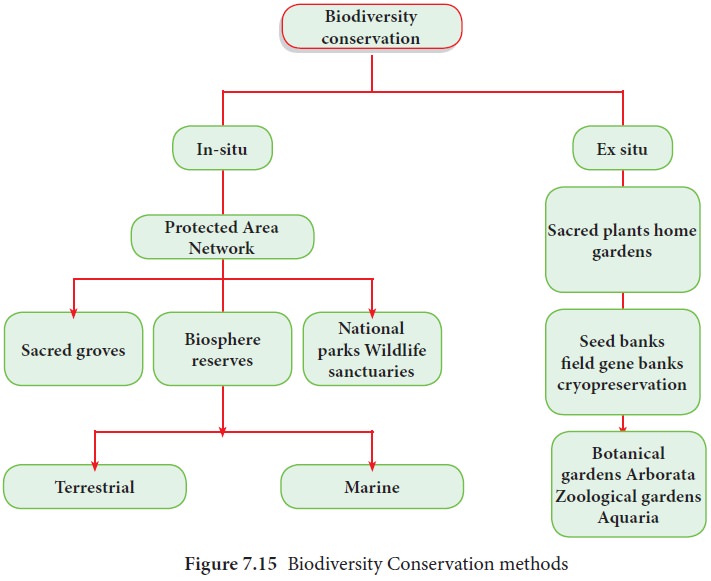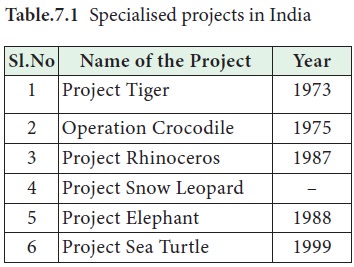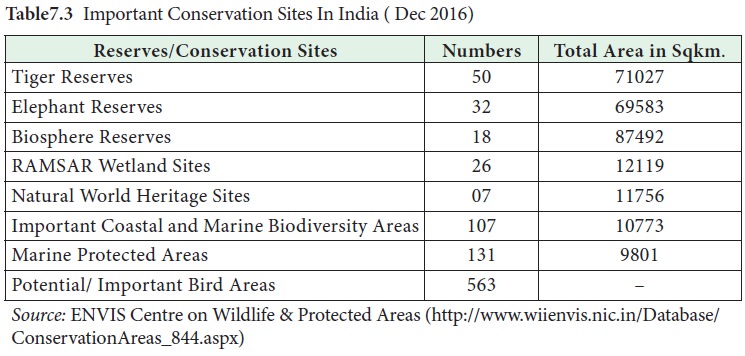India | Biosphere - Conservation of Biodiversity | 11th Geography : Chapter 7 : The Biosphere
Chapter: 11th Geography : Chapter 7 : The Biosphere
Conservation of Biodiversity
Conservation of Biodiversity
Conservation of bio-diversity is the proper management of the biosphere by human beings in such a way that it gives maximum benefits for the present generation and also develops its potential to meet the needs of the future generations.
The three basic objectives of biodiversity conservation are :
a. To maintain essential ecological processes and life supporting systems.
b. To preserve the diversity of species.
c. To make sustainable utilization of species and ecosystems.
There are two types of conservation methods (Figure 7.15) namely in-situ and ex-situ conservations.

In-situ conservation means the conservation of species within their natural habitats. This strategy involves identification of species rich areas and adopting methods to protect it in the form of National Park or Wildlife Sanctuary or Biosphere Reserve etc. In this way biodiversity can be conserved in their natural habitat from human activities.
Ex-situ conservation involves maintenance and breeding of endangered plants and animals under partially or wholly controlled conditions in specific areas like zoo, gardens, nurseries etc.
Other examples of ex-situ conservation include:
a. Seed gene bank
b. Field gene bank
c. Botanical gardens
Biodiversity conservation in India
India is one of the 17 mega bio-diverse countries of the world (according to Conservation International). With only 2.4% of the world’s land area, 16.7% of the world’s human population and 18% of livestock, it contributes about 8% of the known global biodiversity. India has a number of globally important endangered species like Asiatic lion, Asian elephant, one-horned rhinoceros, Gangetic river dolphin, snow leopard, Kashmir stag, dugong, gharial, great Indian bustard, lion tailed macaque etc. The following steps have thus been taken to protect and manage the wildlife of the country.
1. The Government of India enacted the Wild Life (Protection) Act 1972 with the objective of effectively protecting the wild life of this country and to control poaching, smuggling and illegal trade in wildlife and its derivatives.
2. The National Board for Wildlife (NBWL) chaired by the Prime Minister of India, provides for policy framework for wildlife conservation in the country.
3. The National Wildlife Action Plan (2002–2016) was adopted in 2002, emphasizing the people’s participation and their support for wildlife conservation.
4. The Indian Constitution lays the subject of forests and wildlife in the Concurrent list thus laying the responsibility of wildlife conservation on both the Centre and the State.

5. Specialised projects: To save the endangered species of animals, specialised projects are being implemented with international cooperation (WWF, UNDP, UNEP, IUCN) as well as on a stand-alone basis like the following: (Table 7.1)
More recently, the Black Buck (chinkara) the Great Indian Bustard and the snow leopard have been given full or partial legal protection against hunting and trade throughout India.
6. The Protected Areas of India
Protected areas are those in which human occupation is small and exploitation of resources is limited. These are defined according to the categorization (Table 7.2.).

There are 4 categories of the Protected Areas in India.
• National Parks,
• Wildlife Sanctuaries,
• Conservation Reserves, and
• Community Reserves.
National Park
1. National parks in India are IUCN category II protected areas.
2. A National park is an area with ecological, geomorphological and natural significance with rich fauna and flora, designed to protect and to develop wildlife or its environment.
3. Activities like grazing, hunting, forestry or cultivation etc. are strictly prohibited.
4. No human activity is permitted inside the national park.
5. India’s first national park was established in 1936 as Hailey National Park, now known as Jim Corbett National Park, Uttarakhand.
6. There are 103 national parks in India (National Wildlife Database, April 2015).
Wildlife Sanctuary
1. The difference between a Sanctuary and a national park lies mainly in the rights of people living inside. In a Sanctuary, certain rights are allowed but in a national park, no rights are allowed for grazing of any livestock. In a wildlife Sanctuary, the Chief Wildlife Warden may regulate, control or prohibit certain activities.
2. There are a total of 537 wildlife sanctuaries in India.
Conservation reserves and community reserves in India:
1. These terms denote the protected areas of India which typically act as buffer zones between established national parks, wildlife sanctuaries and reserved and protected forests of India.
2. They are called as ‘Conservation Reserves’ if they are uninhabited and completely owned by the Government of India but used for subsistence by communities.
They are called ‘Community Reserves’ if a part of the land is privately owned.
Biosphere Reserves: A biosphere reserve is an area of land or water that is protected by law in order to support, sustain and conserve ecosystems.
Biosphere Reserves of India protect very large areas of natural habitat that are much bigger than national parks or wildlife sanctuaries. Biosphere reserves may cover multiple national parks, sanctuaries and reserves which are contiguous.example, the Nilgiri Biosphere covers: Bandipur National Park, Mudumalai Tiger Reserve, Silent Valley National Park, Nagarhole National Park and Mukurthi National Park.(Figure 7.16)

Biosphere reserves are traditionally organized into 3 interrelated zones, known as: Core area, Buffer zone, and Transition zone.
Presently, there are 18 notified biosphere reserves in India. Ten out of the eighteen biosphere reserves are a part of the World Network of Biosphere Reserves, based on UNESCO’s Man and the Biosphere (MAB) Programmed list. buffer zones between established national parks, wildlife sanctuaries and reserved and protected forests of India.
They are called as ‘Conservation Reserves’ if they are uninhabited and completely owned by the Government of India but used for subsistence by communities.
They are called ‘Community Reserves’ if a part of the land is privately owned.
7. Biosphere Reserves: A biosphere reserve is an area of land or water that is protected by law in order to support, sustain and conserve ecosystems.
Biosphere Reserves of India protect very large areas of natural habitat that are much bigger than national parks or wildlife sanctuaries. Biosphere reserves may cover multiple national parks, sanctuaries and reserves which are contiguous.example, the Nilgiri Biosphere covers: Bandipur National Park, Mudumalai Tiger Reserve, Silent Valley National Park, Nagarhole National Park and Mukurthi National Park.(Figure 7.16)
Biosphere reserves are traditionally organized into 3 interrelated zones, known as: Core area, Buffer zone, and Transition zone.
Presently, there are 18 notified biosphere reserves in India. Ten out of the eighteen biosphere reserves are a part of the World Network of Biosphere Reserves, based on UNESCO’s Man and the Biosphere (MAB) Programmed list.
8. Some Other Important Conservation Sites
Tiger Reserves – Project Tiger was launched by the Government of India in the year 1973 to save the endangered species of tiger in the country. Starting from nine (9) reserves in 1973 the number has now grown to fifty (50) in 2016. Table 7.2. gives a list of conservation sites and their numbers in India.
9. Role of communities: Communities are playing a vital role in the conservation and protection of wildlife in India, example:
• Sariska Tiger Reserve: In Sariska tiger reserve Rajasthan villagers have fought against mining by citing the wildlife protection act. In many areas, villagers themselves are protecting habitats and explicitly rejecting government involvement.
• Bhairodev Dakav Sonchuri: The inhabitants of five villages in the Alwar district of Rajasthan have declared 1200 hectares of forests as the Bhairodev Dakav Sonchuri declaring their own set of rules and regulation which do not allow hunting, and are protecting the wildlife against any outside encroachments.
• Bishnoi villages: In and around Bishnoi villages in Rajasthan, herds of blackbuck, nilgai and peacocks can be seen as an integral part of the community and nobody harms them.
The Role of GIS in Conservation of Nature
Recently Geographic Information System (GIS) has been used as a tool to identify new areas that need to be conserved. In the last 15 years Remote Sensing and GIS has been used to developed gap analysis as a method to identify biodiversity (i.e., species, ecosystems and ecological processes) that is not adequately conserved within a protected area network or through other effective and long-term conservation measures. Gap analysis is a method of comparison of actual performance with potential or desired performance. It was thus developed in response to recognition, that protected areas of all types and in all parts of the world do not fully protect biodiversity. Gap analysis is usually applied to fairly large areas of study.
Highlight:
In 1798, in a small village called Vedanthangal near Chennai, the British soldiers shot some storks in the local wetland. The villagers stormed the Collector’s office and made him issue an order not to harm the nesting birds. This took place long before the concept of conservation of biosphere entered our thoughts. India has experienced many such incidents only some of which have been recorded.
Biodiversity is necessary for our existence as well as valuable in its own right. This is because it provides the fundamental building blocks for the goods and services that provide us with a healthy environment.Biodiversity includes fundamental things to our health like fresh water clean air and food products, as well as many other products like timber, medicine and fibre.
Biodiversity also includes various other important things and services such as cultural, recreational and spiritual nourishment that play an important role in maintaining our personal life and social life.
It is therefore the duty of every citizen to conserve this valuable life on earth, the most precious gift we can pass on to the future generations.

Related Topics